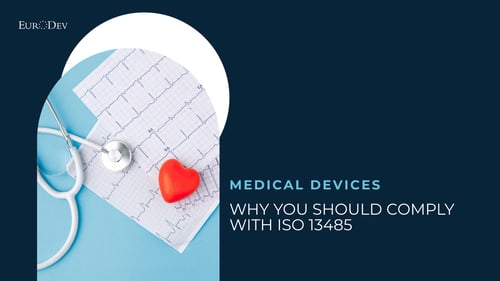The Top 5 Trends and Developments In The Medical Device Industry
The Medical device industry has continuously experienced an increase in the need to develop innovative technologies that are very vital to the prevention, diagnostics, monitoring and medical treatment of diseases. The industry has further invested in the use of technical intelligence to provide a better quality of life to patients. During the start and the peak of the COVID-19 pandemic, the medical technologies market grew by 10-14%. To respond to the unprecedented challenges presented by the pandemic, medical device companies extensively implemented disruptive innovations like artificial intelligence, machine learning, industry 4.0 solutions, and many others. For this reason, many healthcare companies and hospitals altered the way they responded to patients.
To help you keep up with the continuing emerging trends and developments in the medical device industry, we compiled a list of technological trends that are expected to continue growing in this specific industry. Trends and developments include wearable medical devices that can monitor patients remotely. These developments are predicted to change the way the world responds to different medical situations. The whole chain is becoming increasingly important hence there is a great need for medical device companies who adopt an integrated platform approach.
1. Cybersecurity
According to several healthcare reports, the number of cyber security attacks made on the industry has continuously doubled in the last couple of months compared to 2021. More risks are indicated to be faced by the SMEs because of the lack of cyber security expertise amongst the employees. Hence manufacturers of medical devices should be aware and more vigilant when designing user-friendly products that are protected against cybersecurity attacks.
Furthermore, while the connectivity of the medical device is advantageous for monitoring patients and the easy function of the hospital, it has been identified that connected devices are prone to the risk of cyber security attacks. The attack on one device could quickly spread to the other devices on the network, significantly increasing the cyberattack reach. To ensure that hospitals and manufacturers limit the threat of these attacks, it is recommended that companies should strengthen authentication schemes. This would help put limits on the duration of sessions when an offsite device connects to an onsite server. Also, it is good to regularly check whether the data that originated from external sources is compliant with applicable protocols. Finally, all employees must be aware of how to regularly change their passwords.
2. 5G Technology
With the introduction of the 5G technology in the medical device sector, it has recently become very easy for physicians, surgeons, and radiologists to access patient information. The 5G networks streamline real-time data transfers, which is very important for a fast and accurate diagnosis. In general, the 5G networks have broadened the possibilities for remote patient monitoring. As this technology is targeted at vulnerable people who live in areas where connectivity is limited as well as populations who prefer to receive treatment in their homes. Further suburban hospitals that lack specialized expertise also frequently employ 5G devices to connect to metropolitan clinics. Armed with such tools can help surgeons with acquiring instant feedback.
Bonus reading: European Medical Device Regulations
3. 3D-printed Devices
While there were several supply chain disruptions during the pandemic period, the manufacturing of medical devices was still able to move forward with the use of 3D printing. Research has shown that the 3D-printed medical device market will reach a 4.5billion by the end of 2026, showing a CAGR of 13%. The introduction of additive manufacturing in the medical device sector will potential simply the supply chain. This is because hospitals and other medical facilities can substitute imported medical devices by producing the necessary components and equipment within the hospitals. The use of this technology will ensure doctors can create prosthetics, implants, instruments for surgeries, and many others. These technologies are expected to continue growing in the next couple of years.
4. AT and Machine learning
Artificial intelligence and machine learning algorithms have played a significant role in the medical device sector in the past few years. The importance of these technologies grows with the increasing number of medical devices in the facilities. The new features are potentially predicted to help workers with new insights from the growing amount of data from medical records. Consequently, these tools would also lead to improved diagnostic decisions, hence making while providing high levels of precision. AI and Machine learning features would also help doctors develop more efficient interventions. In the last couple of years, several manufacturers have further used AI technologies to rethink their product development. Mainly, this involves using the software as a medical device (SaMD) for chronic disease management and medical care administration. In 2022, these features are mostly used to detect and treat diseases in oncology, cardiology, gerontology, and endocrinology.
5. Robots in healthcare
Currently, the world is still facing a global labor crisis. In the medical sector, there are limited nurses hence pushing technologies to invent robots that can do the same tasks as nurses. The need for extra assistance has grown further in times of the pandemic. Because of the heavy workloads and burnout, most nurses considered leaving their jobs. Hence the introduction of robots in the healthcare industry would free medical workers from routine tasks such as patient monitoring, disinfecting patient rooms, and many others. Furthermore, robots could be used to target quarantined patients and provide extensive care and attention to those in remote areas. The development of robots in this sector is widely spread in the physiotherapy sector as a way to help patients with injuries.
Bonus read: Activating Your Distributor Network: Medical Device Industry
The future of the medical device industry is in digital innovation
The Medical device industry has continued to grow significantly in different areas, especially in regulatory compliance. With the compliance dates and regulation deadlines, medical device industries must embrace advanced technologies if they wish to fulfill regulatory compliance policies and other operational challenges. Fortunately, novel technologies such as 3D printing, artificial intelligence, and others are continuing to pave the way for digital innovation in the medical device industry and helping to solve some critical challenges. Even though these technologies are a long way from replacing human interaction and intelligence, they can be important in enhancing operational, efficiency, productivity, and speed, while minimizing the risk of errors.
Helping NA toy manufacturers enter the EU market since 1996
Do you want to know where in Europe the most promising markets for your products lie? EuroDev can help you do market research, identify new business opportunities, and get your sales started in Europe. Our team works across the complex European market. With our local expertise, we help you understand the diversity of Europe while helping your company to gain a foothold in the European toy industry. We are the first call you should make if you are looking forward to selling toys to the EU.
Category
Related articles
-

MEDICA: Expanding Horizons to Europe
7 November 2023Explore the opportunities for expanding your healthcare business into Europe with the Medica trade...
Read more -

Unleashing the Potential of Digital Health Market in Europe
26 June 2023Digital Health Market in Europe is growing each year, which opens more opportunities for foreign...
Read more -

Quality Management System (QMS) and ISO 13485
15 May 2023This blog is about quality management systems (ISO 13485), one of the most important requirements...
Read more

